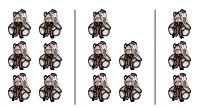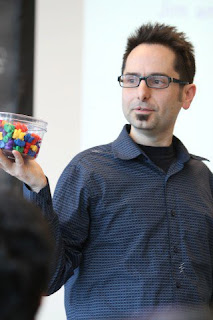The job market in NYC for teachers and schools has reached a new level of irrationality this year with unreasonable threats of a massive teacher layoff (yet again), and a seemingly eternal (yet porous) hiring freeze that separates a pool of talented but anxiety-ridden teaching applicants from ever more desperate public school principals in need of qualified instructors.
My prediction is that the big winner this year is the charter school. This is not a big surprise; their lack of restriction in hiring gives them unfettered and early access to the candidate pool. I’ve also heard that they have a direct line to bottomless pits of hedge fund monies.
A lack of restriction and unlimited funding is one thing, but last week I saw an unstoppable weapon, the charter school recruiter!
I met my first recruiter last week while observing one of my MAT math students at one of my favorite urban high schools on the Lower East Side of Manhattan. My student was doing a brilliant job: he was motivating, provided excellent scaffolding and carried out a wonderfully planned lesson. Several times throughout the lesson, his students had truly become thinkers and mathematicians.
And then, a stranger appeared. In walked an elegant and confident young lady. She was dressed for success and exuded expertise. In the clearest pantomime performance I’ve seen, she asked my student teacher, “can I videotape your lesson with my flip video recorder?” Then she sat down next to me in the back of the room, and I introduced myself.
It turns out that she is one of two full-time recruiters working for a cluster of four charter schools in Harlem. She was following up on my student’s interview with a visit to his classroom, just long enough to let him know that they were very interested, and to record some footage of his lesson for the charter school principal.
Even in this market, where I expect many of my amazing students to linger on the job market through the summer, and to be excited when any tenuous job offer comes in (after the first day of the school year, and with a long commute), I knew that this student was not going to be on the job market for long.
The best teaching candidates never stay on the market, even in the worst of times. (I suspect that the very best candidates never even step foot on the job market.) But there are exceedingly good teachers on the market right now. This week, the job market is HOT!
Last year an extremely good math candidate contacted me for help finding a job. I sent out emails, made phone calls on her behalf, and offered her encouragement (there was a lot of anxiety even in last year’s market). Five days later, she landed her first interview on a Friday. The school immediately invited her in for a demo lesson on Tuesday and offered her the job on the spot. She wrote to me that “Surprisingly, Discovery HS took three days to carry out the hiring process- interview, demo and decision making.” In all, she was on the market for only 7 weekdays.
How can we compete with professional recruiters, and schools that can turn around a hiring decision in just three days? It may seem simplistic or silly, but I think it is easy:
Confirm receipt. When a prospective hire applies, they should get a personal response promptly. This immediately reflects that they will be treated with respect, from the very beginning.
Explain the process. The worst part about being on the job market, is the experience of limbo. It takes almost no effort to explain how the hiring process will work, and approximately how long each part will take.
Check completeness of the application. Let them know if there is anything missing, and if so, what it is.
Interview them if they are of interest.
Let them go if they’re not. Don’t keep their hopes up, but say it nicely.
Inform them what comes next. How long will it take? How close are they to a hiring decision?
Answer them promptly. Don’t let a decision linger!
If you’re curious how I know that this method works, just check out what the first initials spell. This is exactly why the MAT program brings in students year after year, and is able to compete with the more established schools, as well as the cheaper programs.
Happy Hiring!








